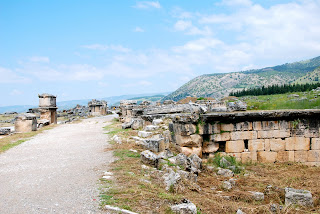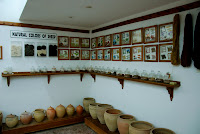The Peace Corps Partnership Program Project I've been working on with my colleagues is online!
Camp Forest Kingdom, a three-day camp for 35-40 children ages 7-14 in the Balkan Mountains, encourages children to respect the environment and to use their imagination and creative arts for positive self-discovery. Organized by the municipality and community partners in 2009 and 2010, the camp is a highly anticipated local event. This project will ensure its sustainability for years to come and establish it as a regional leader in outdoor youth activities.
To remove dependency on external sources and raise the camp's environmental and safety standards, project funds will be used to acquire lasting equipment such as an outdoor kitchen and camp toilets. Between camps, the municipality will manage a transparent equipment rental system, using proceeds for camp improvements and scholarships.
Prior to this year's Camp Forest Kingdom, 5-10 older children will be selected to participate in a three-day leadership work camp. They will learn campsite construction and outdoor safety skills from local volunteers and gain hands-on experience marking trails, building a compost bin, and constructing an eco-friendly campsite. During Camp Forest Kingdom, youth leaders will set positive examples for younger children and share their knowledge with peers.
Camp Forest Kingdom is especially important to the community. The camp provides an affordable and safe environment for youth to interact with nature and build outdoor skills while strengthening their special connection with the mountains of their home.
Visit the Peace Corps website to get involved!
24 May 2011
13 May 2011
11 May 2011
Pamukkale, Hieropolis, and Ephesus
Pamukkale and Hieropolis
The ancient city of Hieropolis and the natural mineral formations of Pamukkale, ‘cotton castle,’ are in the Denizli Province, about 3 hours from our hotel in Kusadasi. Created by hot springs that continue to fill warm pools on its surface, Pamukkale is a popular attraction for Russian and Polish tourists who believe its waters have healing and fortifying properties. They are not the first to believe this; it has been used as a spa since the 2nd century BC.
Hieropolis, an ancient city built next to the top of Pamukkale, was a Greek spa town turned into Roman city of a 100,000. Thousands of people visited for the medicinal properties of its hots springs; although, as the tour book I had wittily pointed out, the extensive walkway through sarcophagi makes one wonder how effective these waters were.


I wish these pictures could better show how huge Hieropolis was. The path through the ruins was several kilometers with very few people on them. Most of the tourists seemed more interested in soaking in the pools on Pamukkale and adding to their sunburns.


I wish these pictures could better show how huge Hieropolis was. The path through the ruins was several kilometers with very few people on them. Most of the tourists seemed more interested in soaking in the pools on Pamukkale and adding to their sunburns.
Ephesus
Ephesus an ancient city during the Greek and Roman Empires had a population of 250, 000 people in the 1st century BC making it the world’s second biggest city at the time. The area around Ephesus was inhabited as early as 6000BC, but didn’t become a proper city until the Bronze Age.
After being attacked by the Goths in 263 AD, the city began declining though it wasn’t fully abandoned until the 15th century. Once a port city on the Aegean Sea, Ephesus now lies 5 kilometers from the coast. The river Küçük Menderes deposited tons of silt in the harbor each year. Despite efforts to dredge the harbor, even as far back as Roman times, the coast continued to retreat from Ephesus. Decline was further hastened by an earthquake in 614 and further attacks by Arabs in 654-655, 700, and 716 AD.
 |
| Unlike Pamukkale, there were tons of tourists at Ephesus. |
Ephesus played a big role in the early development of Christianity. The Apostle Paul lived there in the 50s and a house nearby is believed to have been where Mary lived until her death. It also the site of the story of the Seven Sleepers, considered saints in the Catholic and Orthodox traditions. The Seven Sleepers, a story also found in the Quran, describes a group of Christian youths who hid in an Ephesian cave to escape Roman persecution around 250 AD. While praying in the cave, they fell asleep, awaking 150-200 years later and finding Ephesus a Christian city. In the Quranic version, a dog accompanied them to the cave and kept watch while the slept.
House of the Virgin Mary
House of the Virgin Mary, 4 kilometers from the Ephesus ruins, is where people believe Jesus’ mother came to live with John. The Third Ecumenical Council and Second Council of Ephesus were held there in 431 and 449. Today, people write wishes on cloth or napkins and tie them to a prayer wall, light candles, and drink water from the three natural springs which are supposed to help with health, wealth, etc.
Peace and Friendship Square, Kusadasi

10 May 2011
Cappadocia
I recently returned from a fantastic trip to Turkey with my parents, aunt, and cousin. After arriving at Sirkeci Station, the last stop of the Orient Express, we embarked on a whirlwind tour of Istanbul, the cave cities of Cappadocia, and the ancient cities near Izmir.
Our time in Cappadocia was my favorite, it wasn't very crowded, the weather was nice, and the things we saw were incredible. Cappodocia is located in the center of the country, a few hours away by plane.
Göreme
We stayed in a hotel with rooms built into the rock like a cave. It was a very nice hotel. Though the weather was pleasant during our visit, apparently the summers heat and winter cold can be very extreme. By building homes (or hotels) inside of rocks, as has been done there for centuries, people are able to keep indoor temperatures reasonable without absurd heating/cooling bills.
Rose Valley
Cave churches and once inhabited homes, now high up on the cliffsides, are scattered along the 4 kilometer hike through the valley. Later in the day, we visited the Göreme Open Air Museum, a walk through park with frescoed churches from the 10th, 11th, and 12th centuries.
Rock Castles: Üchişar & Ortisar
When the caves were no longer used for human inhabitation, they were transformed into pigeon homes. The pigeons provided farmers with fertilizer.
 |
| Pigeon Homes |
 |
| Can you guess? This was Pigeon Valley. |
The Kaymakli Underground City was created by the Hittites and expanded thereafter. The Underground Cities, of which there are 36 in Cappadocia, were not intended for permanent habitation, but were used to escape marauding armies that passed through. They fell into disuse and was forgotten until its rediscovery in the 1900s.
Kaymakli is believed to have been able to sustain between 3,500-5,000 people for an extended period of time. It extends 8 floors down, about 360 feet into the earth. The nature of the rock allowed for kitchen fires to burn without windows, much of the smoke being absorbed by the soft stone.
- Entrances to the underground were scattered throughout the surface city, often in the back of barns or cellars. Several layers of doors, sealable by large stones that could only be rolled from one side provided additional security. Water was brought up by a well and ventilation was provided by several shafts. There were rooms for food storage, religious worship, ill or infirm people, the dead, in addition to sleeping and living rooms.
 |
| Inside the Kaymakli |
 |
| Here you can see where tools were used to cut into the rocks. The depression I'm sitting in was used to store pottery-probably with food. |
Avanos
Avanos was the center of pottery making for the Hittites. The Hittites lived in what is modern day Turkey during the Bronze Age from the 18th to 11th century BC. They recorded information from their daily lives on clay tablets and some of the techniques they developed for pottery making are still used today.
The pitcher with the large hole in the center was used for wine drinking during parties. Men would carry it around by sliding an arm through the hole and tilting it to pour.

 |
| Pasabag, or Monks Valley, contains some of the most famous fairy chimney rocks in the region. Churches are built into the rocks and St. Simeon, it is believed, lived here in seclusion in the 5th century |
 |
| Dervent Rock Formations-can you see the camel on the left? |
Despite looking forward to a break from anything to do with carpets or weaving, we visited a carpet weaving co-op in Cappadocia. It is organized by the government and private industry. It was really impressive work they're doing: they preserve traditional skills, provide training, create jobs, make a profit, and educate tourists. The facility is excellent, with all sorts of demonstrations. I would love something like this in Chiprovtsi!
Evil Eyes
The tree below is decorated with nazars, trinkets that are believed to protect against the evil eye. The evil eye curse is attracted to and absorbed by the nazar before it can cause harm. I've seen nazars everywhere during my time in Turkey-on jewelry, airplanes, walls, etc.
I also rode a camel.
Subscribe to:
Posts (Atom)



















